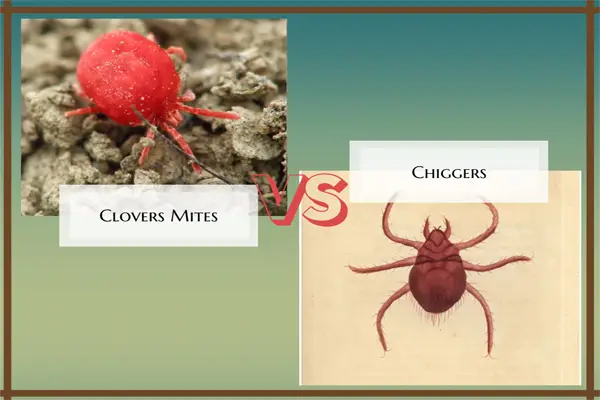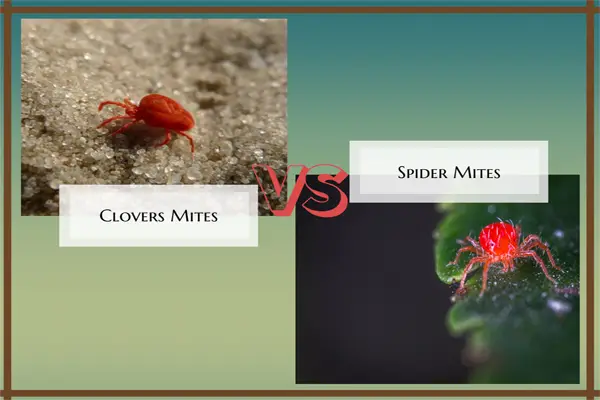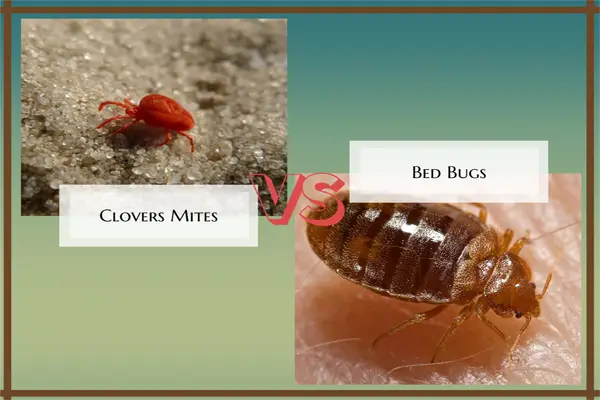15 Facts About Clover Mites [Clover Mites Vs Chiggers, Spider Mites & Bed Bugs]
Clover Mites are tiny red bugs that you may commonly find in your garden. These little bugs are not harmful to animals or humans, but they are a nuisance. They are capable of causing harm to your lawn, as they commonly live within grass beds.
They are sap-sucking bugs, which means they drink the juice out of the grass, leaving it dry or dead. The real problem with these bugs, however, is when they enter the house.
If you accidentally crush any one of them, they will leave a red stain on that surface. The stain is quite hard to remove as well.
Clover Mites may not be harmful directly, but due to their capacity to breed very fast and in large numbers, it’s a good idea to get rid of them as soon as you see them.
In this article, we will take a look at some interesting facts about this mite, so that we can remove them more efficiently.
15 Interesting Facts about Clover Mites
1. What do clover mites look like?
Clover Mites are red in color and are less than a millimeter in length (about 0.8mm). These bugs have 8 legs, the front two being the longest.
To the naked eye, they look like tiny red dots. Upon closer inspection with a magnifying glass, you will be able to see its legs.
Some people mistake the front two legs for antennae, but they are not. They also have a feather-like texture on their body.
2. What do clover mites eat?
Clover Mites feed on plant sap. They drink plant sap from grass, clovers, and several other plants. They have a sharp mouth part, which they use to pierce into a blade of grass or into a leaf to suck up the nutrients from the plant or grass.
Some people mistakenly think that they bite humans and suck blood, because of their red color. However that is not the case at all, they cannot bite humans or animals. They are purely dependent on plant juices.
3. What type of plants do clover mites eat?
Clover Mites like lawn grass, clovers, and other small plants that are close to the ground. These bugs do not fly, therefore they typically don’t affect larger plants.
Some of the plants that are most affected by Clover mites are strawberries, daffodils, primrose, shepherd’s purse, etc. They are also attracted to weed plants.
They are often attracted to ornamental flowering plants as well. In total, clover mites are attracted to over 200 types of plants.
They usually thrive in over-fertilized areas, since the plants in those areas tend to be more nutritious. This means they also like weeds, such as Bindweed, dandelions, thistle, etc.
4. Where do clover mites come from?
Clover Mites usually come from the outside. They thrive in lawns and plants near the ground, so if you find them in your house, chances are that they came from a nearby plant source.
Clover mites can easily crawl into your house during the winter, as they like heat. If you see a dead patch of grass near your house, there may be a clover mite problem.
5. How do clover mites reproduce?
Clover mites prefer a place surrounded by thick vegetation. They reproduce parthenogenetically. The eggs of the clover mites are not required to be fertilized.
They develop from unfertilized eggs and the population comprises only females. The female mites lay around seventy eggs individually in dry areas and where’s adequate sunlight and a balanced temperature altogether.
The eggs of the clover mites are around 0.12mm in diameter and are spherical shaped, and are bright red. These eggs will be hatched, as a consequence of which, the spring generation will come into existence. The resulting generation is usually identical to the mother.
6. How long do clover mites live?
Each Clover Mite can live for 1 to 3 months depending upon the temperature. They thrive in moderate temperatures, which means that they live well during fall and springtime, but die sooner during summer and wintertime.
They can survive the summer and winter too if the temperature does not reach an extreme. These mites give birth parthenogenically, which means there is no requirement for mating.
The entire population of clover mites is female. They lay eggs at around two weeks of age, and the eggs take about 2 weeks to go through all the stages of development. Then these new clover bugs will continue the life cycle.
There is a total of 4 stages in the clover mite life-cycle. These stages are larvae, nymph 1, nymph 2, and adult. Each stage lasts for 2 to 6 days. The eggs can remain dormant during the summer, and hatch during fall.
7. What eats clover mites?
Clover Mites are eaten by most predatory bugs such as LadyBugs, Orius, Geocorisor Big-eyed bugs, etc.
Other than that, clover mites are accidentally eaten by many animals that feed on grass. Since clover mites live on grass, they are commonly eaten along with the grass by deers, cows, goats, etc.
8. Where are clover mites found?
Clover Mites are generally found in lawns, and close to the ground, but they can also be commonly found inside building, as they crawl in through the windows or any other opening.
They lay eggs in sidewalk cracks, cracks in buildings, under tree bark, or anywhere that is dry and safe. So you may be able to find swarms of clover bugs in those areas as well.
9. What attracts clover mites?
Clover Mites are attracted to heavily fertilized lawns. They feed on grass, clovers, weeds, and small plants.
If the ground is fertilized these plants tend to grow better, making it attractive to the clover mites. They also prefer a well-watered lawn, as it helps increase the nutrients in the plants that they drink sap from.
10. How long can clover mites live indoors?
Clover Mites do not live longer than 3 to 4 days indoors. If they do not have a source of food, they will soon die from starvation.
Inside a building, they do not have access to any food source, so if they are left alone, they will die within 3 to 4 days.
If you have indoor plants, they may be able to survive by drinking the sap from the plants. Even then, adult clover mites do not survive more than 30 days.
Keep in mind, they will reproduce if they continue living indoors, so you may have to deal with more clover mites soon if you don’t catch them in time.
11. What are clover mites good for?
Clover mites are not harmful to humans or pets. They are also not a big threat to plants in general. However, they are not good for anything in particular.
12. Clover Mites Vs Chiggers

Chiggers are very tiny, almost invisible to the naked eye, whereas clover mites are big enough to be seen, even though both of them are red in color and have eight legs.
Clover Mites have a specially long set of front legs, they are almost twice as long as their other legs.
Chiggers also have eight legs but they don’t have long front legs. Chiggers are around 0.4mm in length, a magnifying glass is needed to see them. These bugs are also dangerous to humans as they can cause red itchy bumps on your skin.
Most people do not realize that they have been in contact with chiggers until they have red dots on their bodies.
Clover Mites on the other hand are harmless towards humans, and they cannot bite you. You can also spot a clover mite by seeing it with your naked eyes.
13. Clover Mites Vs Spider Mites

Clover mites are not responsible for any serious damage to vegetation however spider mites usually cause harm to shrubs and flowers.
While clover mites carry antennae, spider mites do not have any such part.
Besides these differences, spider mites also complete their development within a week from being an egg to an adult while clover mites take a longer time.
14. Clover Mites Vs Bed Bugs

Adult bed bugs appear reddish-brown. The size of these is almost equal to one-fourth of an inch. These have six legs, unlike the eight-legged clover mite.
Bed bugs, as the name indicates, are usually found around beds. Unlike clover mites, they can attack furniture or wall voids, or places behind the switches in our rooms.
However, bed bugs also do not transmit any diseases. Only minor skin irritations can be observed at times.
15. Do Clover Mites Bite?
Clover mites are not like most of the pests that harm people. These are not even responsible for transmitting diseases or damages. They do not feed on any home-stored products or clothing or furniture.
The problem they cause is leaving stains at places where they are crushed. These stains appear like blood which is a reason why people mistakenly believe that they feed on human blood.
Final Words:
Although Clover mites are not a problem in small numbers, they can easily become a problem as soon as they start breeding. Each Mite lays 70 eggs on average, and since they don’t need a male to breed, they can grow in number really fast.
It is always a good idea to get rid of clover mites as soon as you see them, otherwise, they can take over your house and lawn in no time. So now that you know more about these bugs, we hope that you will be able to get rid of them more easily.
